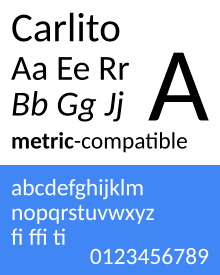Croscore fonts
| Category | Sans serif |
|---|---|
| Foundry | Ascender Corporation |
| Variations | Liberation Sans |
| Website |
fonts |
| Metrically compatible with | Arial |
| Category | Serif |
|---|---|
| Foundry | Ascender Corporation |
| Variations | Liberation Serif |
| Website |
fonts |
| Metrically compatible with |
| Category | Monospaced |
|---|---|
| Foundry | Ascender Corporation |
| Variations | Liberation Mono |
| Website |
fonts |
| Metrically compatible with |
 | |
| Category | Serif |
|---|---|
| Foundry | Huerta Tipográfica |
| Design based on | Cambo |
| Website |
bugs |
| Metrically compatible with | Cambria |
 | |
| Category | Sans serif |
|---|---|
| Designer(s) | Łukasz Dziedzic |
| Design based on | Lato |
| Website |
bugs |
| Metrically compatible with | Calibri |
The Chrome OS core fonts, also known as the Croscore fonts, are a collection of three TrueType font families: Arimo (sans-serif), Tinos (serif) and Cousine (monospace). These fonts are metrically compatible with Monotype Corporation’s Arial, Times New Roman, and Courier New, the most commonly used fonts on Microsoft Windows operating system, for which they are intended as open-source substitutes.[1][2]
Google licenses these fonts from Ascender Corporation under the Apache License 2.0.[3][4][5]
The fonts were originally developed by Steve Matteson as Ascender Sans and Ascender Serif, and were also the basis for the Liberation fonts licensed by Red Hat under another open source license.[2] In July 2012, version 2.0 of the Liberation fonts, based on the Croscore fonts, was released under the SIL Open Font License.[6]
The fonts are also available at Noto fonts repository at Github.[7]
Crosextra fonts

In 2013, Google released an additional Crosextra (Chrome OS Extra) package, featuring Carlito (which matches Microsoft's Calibri) and Caladea (matching Cambria). [8] These two fonts are respectively metric-adjusted versions of Lato[9] and Cambo[10], both available on Google Fonts.
See also
- Droid, a font family by the same font designer
- Liberation fonts
References
- ↑ "Package: fonts-croscore". Debian Packages. Retrieved 3 October 2014.
- 1 2 Nathan Willis, Liberation fonts and the tricky task of internationalization, LWN.net, 19 June 2012.
- ↑ "Google Fonts Arimo". Google Fonts. Retrieved 3 October 2014.
- ↑ "Google Fonts Tinos". Google Fonts. Retrieved 3 October 2014.
- ↑ "Google Fonts Cousine". Google Fonts. Retrieved 3 October 2014.
- ↑ "Overview - liberation-fonts - Pagure". Fedorahosted.org. Retrieved 30 June 2018.
- ↑ "noto-fonts/hinted at master". GitHub. Retrieved 31 January 2018.
- ↑ "Substituting Calibri and Cambria Fonts - Debian Wiki". Wiki.debian.org. Retrieved 7 October 2017.
- ↑ Greffrath, Fabian. "Debian -- Details of package fonts-crosextra-carlito in sid". Packages.debian.org. Retrieved 11 October 2017.
- ↑ Greffrath, Fabian. "Debian -- Details of package fonts-crosextra-caladea in sid". Packages.debian.org. Retrieved 11 October 2017.